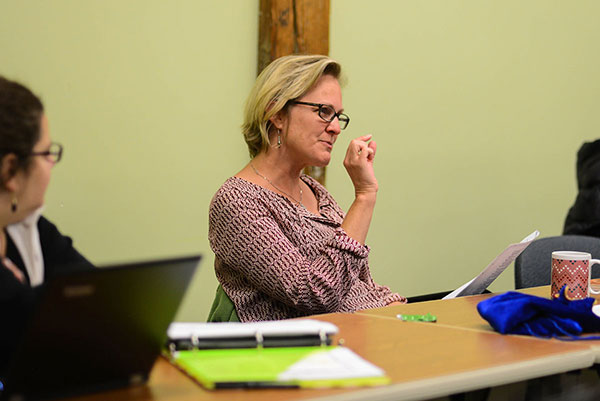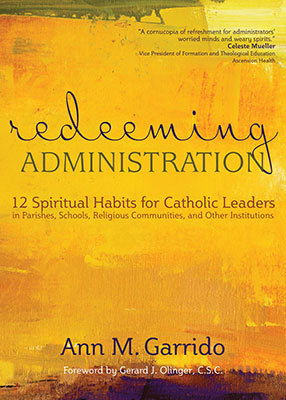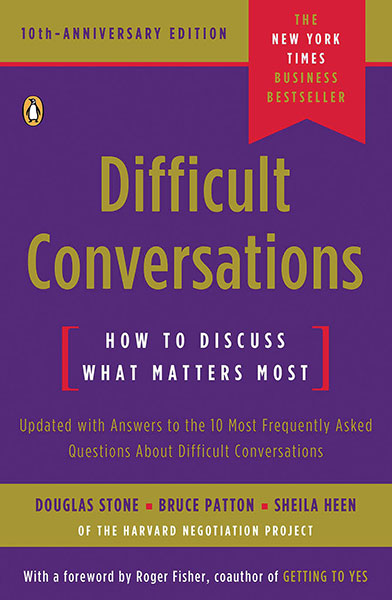 |
Ann Garrido teaching a seminar at Aquinas Institute of Theology.
Credit: Dave Moore |
Ann Garrido doesn’t believe that all conflicts can be resolved. Neither does she think that they need to tear a community apart. Rather, in a dynamic institution with invested stakeholders, she believes that conflicts are opportunities for institutional, professional, and personal growth and thriving. She has seen this at work in her own institution, Aquinas Institute of Theology in St. Louis. And as a consultant for Triad Consulting Group, she teaches others how to have difficult conversations and “redeem” conflict.
Garrido is an associate professor of homiletics at Aquinas, where she has served in various administrative capacities for 18 years. She is also the author of Redeeming Administration (Ave Maria Press, 2013) and Redeeming Conflict (Ave Maria Press, 2016).
Q What started you on the path of researching and thinking about conflict?
A It was the students. After graduation at Aquinas, we gather feedback from students about how we are doing, and they have often reported that we do a great job in teaching them about the church that could be. We don’t necessarily do a great job teaching them about how to minister in the church that is.
When I began using the book Difficult Conversations: How to Discuss What Matters Most in the pastoral ministry courses that I was teaching, one of the things that students said was, “You’re teaching us how we can have these difficult conversations out in the field, but we’re not actually seeing you all as a faculty and staff do these things.” Clearly, there was a misalignment between our professed theology of conflict and our operative theology of conflict.
 |
| Redeeming Administration: 12 Spiritual Habits for Catholic Leaders in Parishes, Schools, Religious Communities, and Other Institutions, by Ann M. Garrido (Ave Maria Press, 2013, 224 pp., $15). |
Much of what is learned in seminary in terms of ministry is “caught rather than taught,” and we realized we wanted to create a culture of engaged conflict — a place where students could see what good conflict could look like within a church setting. We wanted them to see that people of good will and deep passion for ministry could disagree, and we wanted them to see what conflict would look like if handled in a healthy way. When our students graduated, as they entered congregational life, we wanted them to go with a sense that productive conflict is possible.
So we challenged ourselves as a faculty and staff to change the culture of conflict and articulate a theology of conflict. And that meant modeling it with one another for the sake of equipping our students with a healthy capacity for ministry.
Q What does “articulating a theology of conflict” and “changing the culture of conflict” look like?
A We received a grant from the Wabash Center to support “pursuing a culture of engaged conflict.” Then we brought in one of the co-authors of Difficult Conversations to do a two-day retreat with us as a faculty. We also trained all of our field educators who work with our students, and we presented a workshop on negotiation. We did a pretty comprehensive project that I would say has had a longstanding impact on the institution.
Q What kinds of changes did you see in your school’s culture?
A The first change that we saw — which I was at first highly alarmed by — was that we ended up having a lot more conflict with one another. We did a survey with the faculty before we began the program, and then at the end of the grant project. We asked faculty how much time they spent in conflict each week, having difficult conversations with other people with whom they were upset. And we also asked them how much time they spent avoiding conflict — how much time was spent doing other people’s jobs for them, figuring out ways not to work with a particular person.
The first survey suggested that the average faculty member was spending something like six hours a week doing “workarounds” to avoid conflict and only about 30 minutes a week actually involved in conflict. One of the faculty members reported that she lost about 17 hours of productivity a week in doing workarounds. We recognized that in avoiding tough conversations with each other, faculty members were losing a lot of productivity.
After the programs, the follow-up survey revealed that even though there was more conflict going on, it was taking a lot less time. We were bringing things up quicker, we were talking to each other more readily, and things were getting solved or managed quicker.
Q You’ve talked to many groups about conflict. What preconceptions do people bring to the conversation?
A Some people find conflict kind of exciting. Some people like to cause conflict. Some people enjoy upsetting the apple cart just to see what will happen.
But many people, especially in the field of Christian ministry, have a tremendous desire to avoid conflict. The reason they avoid conflict is that as Christians, they associate conflict with sin. They share a preconception that if there is disagreement someone must have done something wrong; there is fault involved. Sin does escalate conflict, bringing it to the level of bitterness and even violence, but it is possible for people of tremendous good will and holiness to disagree with one another without it meaning someone is doing something wrong.
 |
| Difficult Conversations: How to Discuss What Matters Most, by Douglas Stone, Bruce Patton, and Sheila Heen (Penguin Books, 2010, 352 pp., $20). |
Q Much of the work with conflict is teaching individuals how to handle conflict better. Is there an institutional role? Is there a way for a seminary to create a culture that’s more open? For example, can the president model good strategies?
A Everybody can work on developing their own capacities for having difficult conversations, but what leadership within schools can do is to create a culture of healthy conflict, and that takes a lot of work. I don’t want to put all of that work on the president. I think the president has a really significant role in doing that, but each and every one of us, from the grassroots on up, can be part of the culture of healthy conflict.
One of the things that the school can do is to establish expectations up front. “Because we all care about the mission of this school, and because people argue about the things they care about, we expect tensions.” The president can say, “As a leader of the school, I expect there will be tensions. The question is, how do we want to handle tensions as they emerge?”
These questions can help establish a group covenant that answers the question of how to disagree. The other thing a leader of a school can do is to model what everybody who works at a school should be doing.
Q What does productive conflict look like? How do you “redeem” a difficult conversation — one that has the potential to leave people with bruised egos and negative feelings?
A One of the first things is to make sure that your purposes are manageable before you enter into the conversation. A lot of times we go into tough conversations thinking, “I’m here to change your mind —my purpose is to persuade you to see things from my point of view.” Or we go into the conversation just thinking, “I’m going to give you a piece of my mind, and I’m going to let you have it.”
I would say those are not productive aims. If I have right-sized my purposes before I enter into the conversation, I have a much better chance of achieving a positive outcome. So I don’t go into a conversation unless I have a genuine question in mind — something to ask that I don’t know the answer to. A good purpose for going into a conversation is to get more information. A second purpose is to share my own perceptions. I may not be able to persuade you to see things my way, but there’s value, for the sake of my own integrity, in saying how I see the situation. A third purpose is to invite problem solving. I can invite you to stand alongside me and ask, “Can we figure out how to work on this issue together?”
Those three things are manageable. If I’ve gotten myself into a space where those are really my aims in the conversation, I would say half of the hard work is done, because I’ve set myself up for a productive conversation.
Q Many seminary board members have experience in the corporate world. Is conflict handled differently in the business culture than in the culture of seminary education?
A Because many businesses make a conscientious effort toward leadership development, board members with business backgrounds may have been through some sort of leadership training. For some, such training has included executive coaching or workshops on difficult conversations and change management.
 |
| Redeeming Conflict: 12 Habits for Christian Leaders, by Ann M. Garrido (Ave Maria Press, 2016, 288 pp., $16). |
Those of us who have come through the seminary system have likely not had those opportunities, and many of us are conflict avoiders. This can put us at a disadvantage within board dynamics, because we have different patterns of handling conflict.
The board can be confused by the way decisions are made in higher education. Sometimes when they observe things at the seminary, they’re thinking, “I can’t believe this has been going on. Why didn’t you just talk about this?” Or “Where’s the leadership on this?”
If we really want to assess difficult conversations, we need to ask two questions. First, did we get what’s inside of our heads and hearts out onto the table? And second, is the relationship better or worse for this?
Polite cultures often value the second one so highly that they never get to the first one. Business cultures value the first one so highly that they never get to the second one. Really, both of those concerns are of high value. We want to make sure we say what’s going on inside us, but do it in a way that the relationship can continue to be sustained, and even deepened, rather than fragmented.
Q What are the first steps a school can take to create a better culture for engaged, productive conflict?
A First, make sure to articulate that conflict is normative. Second, equip your people for conflict. Do some leadership development within your staff, administration, and faculty to give them the skills to do this well.
I hope Redeeming Conflict is helpful for schools that need a resource in this area. There’s a free study guide that’s downloadable from Ave Maria Press’s website (bit.ly/Small-Group-Guide). It can be used in faculty or staff meetings. Also, on the Triad website (bit.ly/triad-worksheet), there’s a “Difficult Conversations Preparation Worksheet” that can get you ready for a conversation you know you need to have.